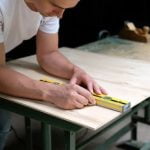Introduction What Are Pocket Holes in Woodworking?
Pocket holes in woodworking are a method of joining two pieces of wood that involves making a hole into the edge of the first piece at an angle and then inserting it into the second. The hole is then secured with a pocket screw. This is an efficient, low-cost way to join wood without using complicated tools and having to create complex saw cuts. Additionally, pocket holes create a tight, strong joint that can last for decades if done correctly and with proper care. Many experienced woodworkers prefer this jointing technique because of its simplicity and strength. Pocket screws are also easier and faster to install than nails or other conventional fixing methods like dowels or mortise and tenon joints. Wood projects created with pocket holes have professional-looking results, making them great for all levels of experience from beginners to professionals alike.
Advantages and Disadvantages of Using Pocket Holes
Pocket holes are a technique used in woodworking to join pieces of wood without the need for visible fasteners. It involves drilling an angled hole into one piece of wood and inserting a connector, usually made of wood or plastic, into the hole. The excessive material between the hole and the connector serves to form a pocket that helps hold the two connected pieces in place.
The advantages of using pocket holes include their versatility – they can be used with any type of wood – as well as their ability to provide a strong bond between two pieces of material. They are also quick, easy, and inexpensive to make, making them particularly useful for DIY projects where time and cost are limited. Additionally, the lack of visible fasteners means that furniture produced with this technique will look seamless when put together.
The disadvantages of using pocket holes include their potential instability if used incorrectly. For example, joining two boards with pocket holes which have been drilled at an incorrect angle may mean that they are not held securely in place and could possibly come apart in time. Additionally, destroying large amounts of excess wood is often unavoidable when drilling these holes which can prove costly if a project is already tight on materials or budgeted time. Finally, some people feel that the aesthetics can be compromised as it does not give off a traditional furniture look as a result of not having exposed screw heads.
Types of Pocket Hole Joints
Pocket hole joints are a common type of joinery in woodworking. This type of joint does not require tools that are expensive or difficult to use, allowing you to easily create secure and relatively attractive joint connections. It is an ideal joint for construction materials that are made from pressed-wood sheets (such as plywood), particle board and medium density fiberboard which don’t usually have stable end grain on the edge surfaces.
The main type of pocket hole joint has two components: a pocket hole that is drilled into one of the edges of the sandwiched boards and then a special wood screw that goes through it. There are different types of pocket holes, depending on the wood being joined and the desired strength of the connection ” such as blind pocket holes, through pocket holes, deck screw pocket holes, plug pocket holes, compound Pocket Hole Joiners (PHJs) etc. Blind pocket holes offer an invisible connection from one side while Through Pocket Holes show the screws from both sides but provide a much stronger attachment. Deck Screws Pocket Holes allow for quicker assembly times for thicker stock and can support heavy loads ” this type of rod requires countersinking and predrilling before driving in. Plug Pocket Holes hide their screws with plugs for a clean finish and higher chance for refinishing in the future whereas Compound PHJs can accept plugs or be filled with putty for a flush look to hide them even further.
Tools Needed for Creating Pocket Holes
Pocket holes are a type of joinery used in woodworking projects. They allow for two pieces of wood to be joined together without having to use specialized tools, such as dowels or mortise and tenon joints. Pocket holes consist of two main components: the pocket hole itself, which is created by drilling a hole at an angle into the surface of one piece of wood; and the screw, which is then inserted through the pocket hole in order to secure both pieces of wood together.
Tools needed for creating pocket holes can vary depending on the size and scope of your project. Generally, you’ll need either a dedicated pocket-hole jig (which holds your drill stationary at the correct angle) or an adjustable thickness jig that can accommodate different sized pieces of wood. You will also need a power drill with a pocket-hole bit, and an appropriate screwdriver bit for driving screws. If necessary, countersink bits can also be helpful in order to ensure that the screws sit flush against the surface of both pieces of wood. Additionally, many folks opt to have clamps on hand in order to help align pieces while screwing them together.
Selection Tips for Choosing the Right Pocket Hole
Pocket holes are a type of woodworking joint used to connect two pieces of wood together. A pocket hole is created with a specialized drill bit which makes one small hole on the edge of a piece of wood and then joins it with a usually-angled screwdriver. Pocket holes are commonly used in furniture making, cabinets, and other construction projects where strong joints are needed.
When selecting the right pocket hole for your project, there are several factors to consider. First and foremost, determine what project you will be using the pocket hole for; different applications have different requirements for size and types of screws to use. The size of the drill bit will vary depending on the material you’re using and the particular type of joinery desired; some materials require longer drill bits than others. You should also choose a pocket hole appropriate for the thickness of your wood so that it can hold all components tightly together when tightened. Furthermore, it is important to understand types of joinery that can be achieved by connecting two pieces of wood with a pocket hole so that you can ensure strong connections regardless of position or angle. Lastly, it is necessary to know various safety precautions related to drilling before beginning any project with pocket holes in order to protect yourself and others from injury or damage due to misused power tools.
Step-by-Step Guide for Building Pocket Holes
Pocket holes in woodworking are an easy and efficient way to join two pieces of wood together. They allow the user to create a strong and durable joint that can be completed quickly. Pocket holes involve drilling two or more angled holes in one board and then screwing the other board into them, creating an internal “pocket” where the screws are fastened. First, decide the location of your pocket hole joints, and make sure the two boards will align correctly when joined. Once you have chosen the locations, use a pocket-hole jig to provide guidance for your drill bit. Then adjust your drill bit’s angle until it meets the specifications for a pocket hole (typically 15 degrees), which is easily visible on most pocket hole jigs. Position the board you wish to join loosely against the jig before drilling to check alignment; once you’re happy with it, press it down firmly before continuing. Finally, drive screws through both sides of the joint, making sure they go into each other’s pockets properly before tightening everything together. Voilà! You have just built a secure joint with pocket holes in woodworking.
Safety Considerations When Creating Pocket Holes
When creating pocket holes in woodworking, it is important to follow essential safety considerations. Firstly, always wear protective eyewear and a face mask when operating the power drill. Secondly, make sure that you are using a drill bit that is compatible with the material you are working with. Finally, be aware of your surroundings and keep hands and other body parts away from the drill bit at all times. Additionally, when drilling pocket holes into hardwoods such as oak or maple, it is wise to use an impact driver rather than just rely on the regular power drill”as this will ensure a secure joint in the finished product.
Common Mistakes When Using Pocket Holes
Pocket holes are a type of joinery technique used in woodworking to make tight connections between two pieces of wood while still leaving an easily accessible space for the insertion of any screws needed. Pocket hole joinery is achieved by drilling a pocket hole in the face or at an angle into one piece, then drilling a corresponding pocket hole that accepts a Kreg screw, which secures the joint together.
Common mistakes when using pocket holes include not countersinking enough and not driving the screws in at an angle. Additionally, when joining two thick sections of material sometimes it’s necessary to over-drill the pocket hole; if this isn’t done the two pieces won’t meet together properly. Also, when pre-drilling the inner piece meant for connection but with limited drill access, it can be easy to accidentally drive too deep and break through, reducing overall stability. Finally, use caution when inserting your Kreg screws as too long or wide can cause splitting of wood fibers and other breakage.
Finishing Pocket Holes
Pocket holes are pre-drilled holes in woodworking, most commonly used to join two pieces of wood together without being visible. They can also be used on closed cabinets and drawer boxes. Pocket holes are created using a jig that drills an angled hole into one board so that a fastener can be driven into the adjacent board through the pocket hole.
Finishing pocket holes is important for aesthetic purposes as well as for their strength and durability. Finishing can involve filling in the pocket hole with a plug made from either the same material as surrounding wood or from another type of plug such as those made from hardwood, plastic, or metal. After the plug has been fitted, glue can be added to further secure it in place. A router may also need to be used to route and finish off edges of the pocket hole prior to inserting and finishing with a plug. Applying caulk around the edges is also important for creating a watertight seal and preventing moisture damage over time. Finally, sanding down the entire surface around the area of the joint will ensure an even finish and improve its overall look.
Final Thoughts on Pocket Holes
Pocket holes are an underrated but extremely useful tool for the woodworker. They allow you to easily attach two pieces of wood together in a safe and secure way, without the need for nails or screws. As long as your pocket hole is cut with high-quality blades, your joint should remain strong and stable over time. With a little extra thought and planning, pocket holes can be used to create beautiful furniture or other woodworking projects that are sure to impress!
Pocket holes make it easy for even novice woodworkers to achieve professional results quickly and easily. By taking the time to learn proper techniques for cutting and drilling pocket holes, you will soon be able to produce excellent joinery in any project you undertake. Additionally, pocket holes are much easier than traditional methods for affixing materials ” so if you’re short on time or just starting out in carpentry, pocket holes may be your best bet for success. Plus, there are plenty of tools available today that make creating pocket holes even simpler ” from specialized drill bits to specialized jigs ” making them more accessible than ever before.
In addition, they provide flexibility when it comes to joining boards since they can be placed at an angle rather than being limited to end-grain joints alone. This allows you to create compound angles in furniture building or cabinetmaking giving your projects more visual interest and distinction from other builds. Lastly, because they also conceal fasteners like screws they can help ensure a pleasing finish where visible hardware is a nuisance or isn’t desired. This makes them especially valuable if the structure needs to sit flush against another surface such as walls or cabinetry – eliminating any unsightly gaps caused by exposed fasteners thanks to the snug fitting nature of pocket hole joints

Hi everyone! I’m a woodworker and blogger, and this is my woodworking blog. In my blog, I share tips and tricks for woodworkers of all skill levels, as well as project ideas that you can try yourself.





